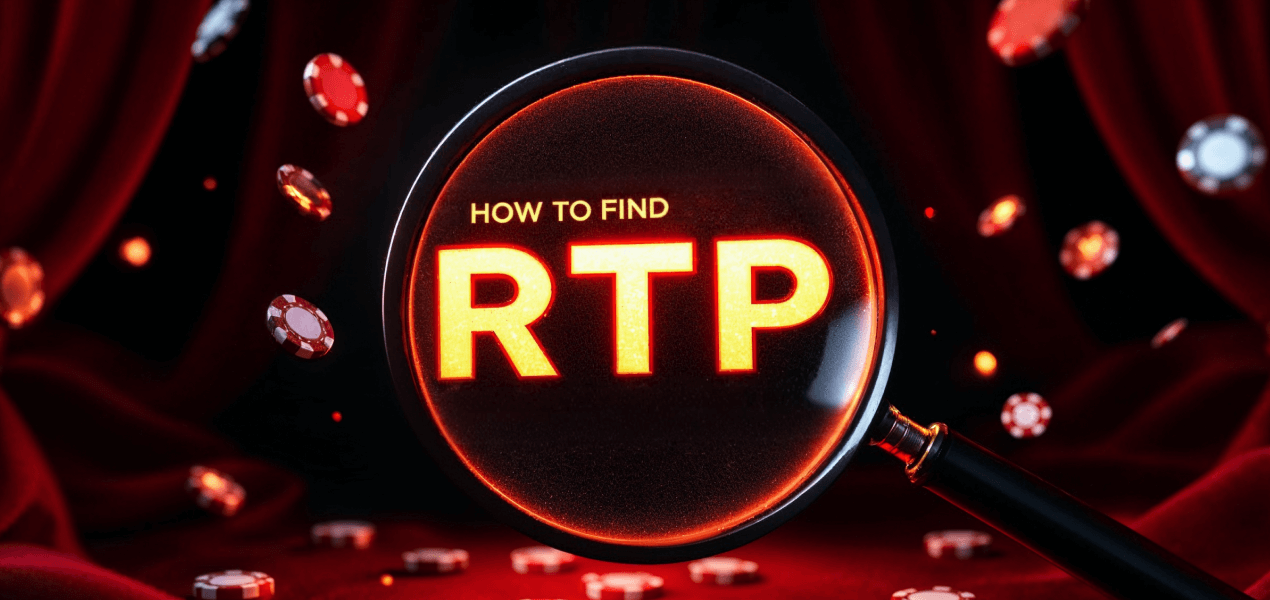
How to Find RTP on Slots


Slot games can be loud, bright, and packed with features. From wild symbols and free spins to bonus rounds and fancy animations, there’s always something going on. But underneath all that noise, there’s one quiet number that can actually tell you a lot about how the game plays in the long run — and that’s the RTP.
RTP stands for Return to Player, and it’s not just some random number. It’s a key piece of information that shows how much money a game is designed to pay back to players over time. Some people chase massive jackpots, while others just want steady, small wins. Either way, knowing the RTP helps you choose games that match your style and budget.
In this guide, we’re going to break down what RTP really means, how it works, and most importantly how you can find it.
Understanding RTP Before You Search
Understanding this concept is essential before you learn how to check slot RTP. RTP, or Return to Player, refers to the percentage of all wagered money a game pays back to players over the long run. For example, a good RTP of 96% means that, on average, $96 is returned for every $100 wagered — over thousands or even millions of spins. It’s the opposite of the house edge, which shows how much the casino keeps.
Not all slots are the same. Whether you’re learning how to play pokies in Australia or anywhere else, you’ll find:
- Low RTP Games: Smaller long-term returns but sometimes offer massive, rare wins.
- Medium RTP Games: A balanced return with regular smaller wins.
- High RTP Games: More consistent payouts, though often with lower maximum wins.
RTP is sometimes referred to as “payback percentage,” and it’s calculated through rigorous testing with random number generators (RNG). While it won’t predict short-term results, it gives a solid idea of how fair a game is designed to be.
Common Places to Find Slot RTP
Not sure where to even begin with RTP? Don’t worry — you’re not alone. If you’re serious about tracking slot RTP information, make sure you check both in-game menus and the casino’s site version, especially when playing on mobile. Depending on the provider and platform (desktop or mobile), that data can be upfront, buried, or completely missing. Here’s where to look first:
- Game Info Section: Most modern slots — especially from providers like NetEnt, Thunderkick, and Quickspin — display RTP information clearly. Some games even rank among the highest paying 99% RTP slots. Tap it to open the Game Info panel. This section is usually easier to navigate on larger screens, and everything loads in one or two clicks. When it comes to mobile, it might require swiping or tapping through multiple collapsible tabs.
- Paytable Location: The paytable tells you how symbols pay and how features work. Some providers slip the RTP in at the bottom of the final paytable page. Always scroll or flip through to the last page, especially on smaller mobile displays.
- Help Menu Details: Some games have a Help section or full game rules page. For instant access to bonus features without waiting for natural triggers, you might want to check out PlayAmo’s bonus buy slots where RTP is typically displayed clearly. These menus are where many providers now hide the RTP. On mobile, this is often shortened or harder to locate. The same slot on the desktop might show the RTP clearly.
- Provider Websites: If all else fails, go to the source. Most providers list RTP in official spec sheets, game libraries, or partner docs. Look for pages like “Games” or “For Operators”, where they publish slot details, including payout percentages.
- Casino Game Info Pages: Some online casinos show RTP in the game summary or under a “Details” tab. However, this info may be outdated or reflect region-specific RTPs. Mobile versions of casino sites often strip out these extras, while the desktop version may show full data.
Step-by-Step RTP Check Guide
Still can’t find that number? Let’s break it down into easy steps. It doesn’t matter if you’re on your phone or using a laptop. You can follow these steps to track down the RTP for any slot — if it’s publicly available.
- Launch the Game: Start by opening the game you’re curious about. Wait for it to load fully — some games delay loading menus on mobile.
- Click the “i” Button or Gear Icon: This opens the game’s details section. On the desktop, this is typically in the bottom-left or top-right. On mobile, it might be a floating icon or part of a burger menu.
- Navigate to the Paytable: Use arrows or swipe gestures to browse through. Scroll to the final page to check if the RTP is listed.
- Look for a Help or Rules Menu: Some games have a separate section for detailed rules. This is where RTP is often tucked away, especially in games from Play’n GO or Pragmatic Play.
- Search the Provider + Game Name + “RTP”: Go to Google and type: [Slot name] + [Provider] + RTP. Example: Book of Dead Play’n GO RTP. You’ll usually land on reviews or the provider’s site.
- Use a Trusted RTP Database: Websites like ThePogg, AskGamblers, or SlotCatalog list RTP data for thousands of games. These are especially useful when in-game info is missing.
These steps should help you verify slot return rate before playing.
Tools and Resources for Finding RTP
Sometimes, finding RTP is less like clicking around and more like doing detective work — but there are reliable tools to help. If you’re serious about picking better games, it’s worth getting familiar with these resources. These platforms are great when you’re unsure where to find slot RTP or need to compare similar games quickly.
RTP Databases
- SlotCatalog: Lists RTP, volatility, provider info, and themes.
- ThePogg: Includes slot complaints, RTP info, and payout testing.
- AskGamblers: Offers detailed slot reviews with RTP when available.
These are fast to search and useful for side-by-side comparisons. Especially helpful when you’re browsing on mobile and can’t open game files easily.
Provider Documentation
Many developers (like Thunderkick or Red Tiger) release official PDFs or web pages for their slots. You’ll find:
- RTP versions (some games offer 92%–96% variants).
- Max payouts.
- Volatility ratings (1–5 scale or “High/Medium/Low”).
Game Review Websites
Independent reviewers break down RTP, bonus triggers, hit frequency, and more. Sites like BigWinBoard or Slots Temple go into detail you won’t find in-game.
Casino Testing Certificates
Look for testing seals from labs like:
- eCOGRA
- GLI
- iTech Labs
While they don’t list individual RTPs, they certify fairness and RNG integrity, which usually includes RTP testing.
Common Challenges in Finding RTP
Finding the RTP of a slot game sounds easy, but it doesn’t always go as planned. Even though many game providers do share this information, there are still a few things that can make it harder to find.
One issue is that some games just don’t show the RTP at all. This is more common with older games or in countries where casinos aren’t required to display that information — like some states in the U.S. On mobile devices, the problem gets worse because game layouts are often simplified. That means less information is shown, and the RTP might be left out completely.
Another problem is that some slots come with more than one RTP version. For example, The Dog House Megaways has versions with 96.5%, 95.4%, and even 91% RTP. Casinos can pick which one they want to offer, but they almost never tell you if they’ve chosen the lower one. Unless you check, you won’t know what version you’re playing.
Regional rules can also get in the way. In some countries, gambling laws don’t allow casinos to show RTP inside the game. So, if you’re playing a slot in the UK, you might see the RTP clearly. But if you open the exact same game from another country, it could be hidden.
Lastly, there’s the issue of outdated information. You might find a game review or a casino listing that shows an RTP value, but it’s based on an older version of the game. Developers sometimes update their slots and change the RTP without making it obvious. That’s why it’s a good idea to check the provider’s website or compare a couple of trusted sources before you rely on any number you see.
Finding the RTP of Land-Based Slot Games
It’s a different game in physical casinos. Most machines don’t show it, but there are still ways to get a general idea:
- Check Gaming Reports: Regulatory bodies like the Nevada Gaming Control Board release reports showing average RTP by coin size. For example:
- Megabucks: 87.93%
- $100 slots: 93.21%
- $25 slots: 95.03%
- Penny slots: 90.17%
These aren’t machine-specific but give a useful overview of what to expect.
- Look at Coin Denomination: Higher denomination machines generally pay better. A $5 slot will usually have a higher RTP than a penny slot. But it’s not a rule — some high-denom machines have lower returns due to low play volume.
- Compare Casino Averages: Some state reports list average payout rates for each casino. If one casino averages 92% and another sits at 88%, the higher one likely offers better odds across the board.
- Ask the Staff (with Caution): Casino workers rarely know individual RTPs. Signs like “Up to 97% payout” often only apply to one machine in a row. Without data to back it up, don’t rely on it.
These methods won’t give you the exact RTP for every slot, but they can help you make smarter choices on the floor.
Top 5 Most Transparent Providers
Some developers make RTP easy to find. Others don’t. If you’re serious about knowing what you’re playing, stick with these studios:
1. NetEnt
- 5/5 for transparency
- RTP is always shown in-game and on their website
- High-quality support and documentation
2. Thunderkick
- 4.5/5
- RTP listed in help sections and spec sheets
- Mobile-friendly games, usually with full info
3. Quickspin
- 4.5/5
- Known for listing RTP and volatility clearly
- Great user interface across all platforms
4. Play’n GO
- 4/5
- Info is often there — but not always obvious
- Some older games may require provider research
5. Pragmatic Play
- 3.5/5
- RTP is present, but varies by casino and jurisdiction
- Known for offering multiple RTP settings per game (which casinos choose from)
FAQ
Why Can't I Find RTP on Some Slots?
Sometimes, it’s just not there — or at least, not where you’d expect. Some older games have never displayed RTP in the first place, and in certain regions, casinos aren’t required to show it. Mobile versions of games also tend to simplify menus, which means RTP might be hidden or left out entirely.
Are Published RTPs Always Accurate?
Usually, yes — if you’re getting the number from a reliable source like the game provider, a certified casino, or a trusted database. But keep in mind: many games come with different RTP versions (like 96%, 94%, or even 91%), and casinos can choose which one to offer. So, double-check, especially if something feels off.
Do Mobile and Desktop RTPs Differ?
The RTP itself doesn’t change based on the device — but what you see can differ. On mobile, games often show fewer details to save space. You might need to scroll more or tap through extra menus to find the same info that's visible upfront on the desktop.
How Often Should I Check RTP?
Every time you try a new game or a new casino. Even if the game looks the same, the casino might be running a different version with a lower RTP. It only takes a minute to check and it’s worth it.
What if the RTP isn't Listed Anywhere?
If you’ve clicked through all the menus and searched online with no luck, try a trusted slot database like SlotCatalog or AskGamblers. Still nothing? You can ask the casino or provider — but if there’s no transparency, it might be best to choose a different game.


